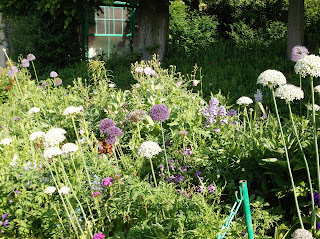 | |
|
The house was known as the House of the Cider-press and had an rectangular orchard in front that was enclosed by tall stone walls. This area is called the Clos Normand, the Norman field. After renting for seven years, Monet bought the house and surrounding orchard in 1890. It was then that he began creating the garden from which he would paint for the rest of his life.
The central alley of the garden was bordered by pine trees which he cut down. Today the central alley is covered with iron arches supporting masses of climbing roses.
It is easy to see that the flowers in the garden are arranged by an artist. Some beds contain flowers of complimentary colors that would have given Monet a pleasingly harmonious canvas, while other blooms came from opposing sides of the color wheel creating vivid contrast. Our tour guide said that each morning Monet loaded a wheel barrow with paints, canvases,and easels. He then had one of his children push the cart to the place Monet chose to paint that day. Bliss!!!
“What I need most of all is color, always, always.” ~ Monet
Monet was an admirer of Japanese art and had an extensive collection of Japanese woodcuts. Three years after buying the house, Monet bought the property across the road. Here a small brook flowed from the Epte, a tributary of the Seine. Using this water, Monet dug and filled a pond so that he could grow waterlilies inspired from his Japanese prints.
“The light constantly changes,
and that alters the atmosphere and beauty of things every minute.”
~ Monet
He had a footbridge built by a local craftsman to go over the pond and he covered it with wisteria. Here he painted his famous waterlily paintings inspired by the light on the water and the reflections in the pond.
It was an amazing experience to stand at Monet's bedroom window and look out at the view he saw each morning.
“My garden is a slow work, pursued with love and I do not deny that I am proud of it. Forty years ago, when I established myself here, there was nothing but a farmhouse and a poor orchard…I bought the house and little by little I enlarged and organized it…I dug, planted, weeded, myself; in the evenings the children watered.” ~ Monet (1923)
“I work at my garden all the time and with love. What I need most are flowers, always. My heart is forever in Giverny.” ~ Monet
Love ya'll,
Shelli











No comments:
Post a Comment